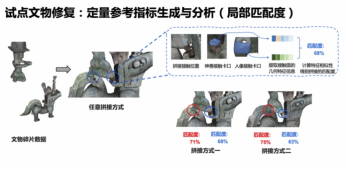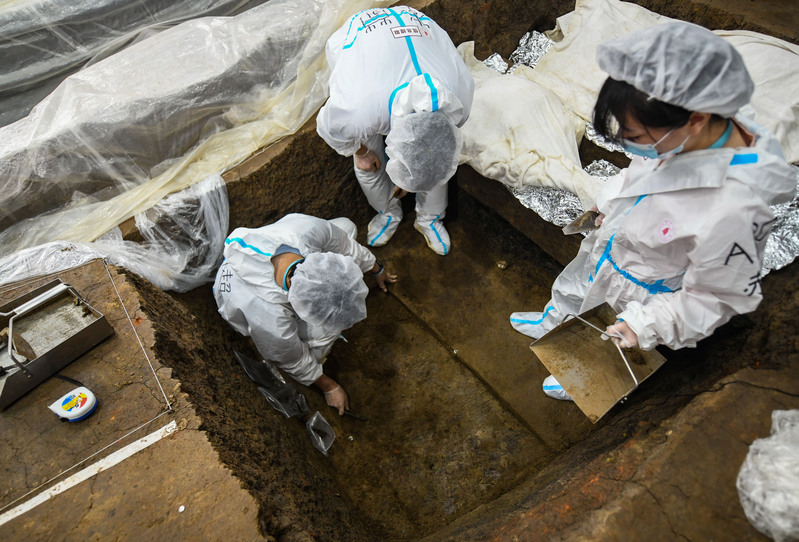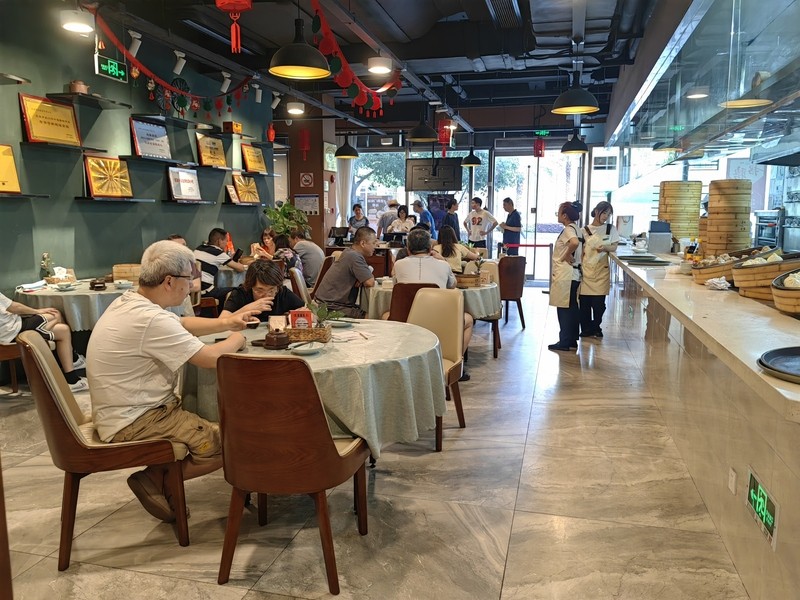How can new technology assist archaeology in finding and tracing cases? In addition to cultural relics splicing AI | scanning | new technology
Recently, two national treasure level large bronze artifacts unearthed from Sanxingdui have been digitally restored, with strong support from AI technology. So, do you know how "digital" restoration is accomplished? Taking the Sanxingdui archaeological site as an example, which new technologies are playing a role? What are some amazing operations in scientific archaeology in China?
The success of "matching" cannot be achieved without AI
On June 10, 2023, two large bronze artifacts successfully assembled across pits in the sacrificial area of the Sanxingdui site once again attracted people's attention. Through technological means such as 3D scanning and 3D modeling, the two national treasures were clearly displayed in complete form in the public's view.
Among them, the bronze beast with a kneeling and sitting human head statue is 1.589 meters high. It is composed of a combination of the kneeling and sitting human statue unearthed from Pit 3 in 2021, the mouth edge of the bronze statue unearthed from Pit 2 in 1986, and the bronze god beast unearthed from Pit 8 in 2022.
The bronze beast kneels and sits with a person holding a bronze statue. Sichuan Provincial Institute of Cultural Relics and Archaeology

The statue of the upside down bird foot top statue of the Copper Lei Zun stands at a height of 2.53 meters, including a copper bird foot human statue unearthed from Pit 2 in 1986, a climbing dragon copper vessel cover unearthed from Pit 3 in 2021, and a copper top statue with a curved body supporting a Lei, a copper holding dragon standing human statue, and a copper staff shaped vessel unearthed from Pit 8 in 2022.
The statue of a deity standing upside down with bird feet on the top of a copper Lei pedestal. Sichuan Provincial Institute of Cultural Relics and Archaeology
The two bronze statues not only achieved cross pit matching, but also crossed decades of archaeological excavation work. Behind this, human-machine intelligent collaborative archaeology has played an important role.
At that time, a new round of cultural relics excavation and cleaning work was gradually advancing. Experts found that many cultural relics unearthed in different "sacrificial pits" in Sanxingdui were actually "a family".
However, due to the high brittleness and overall height of cultural relics, physical assembly will face risks and cause irreversible damage to cultural relics. So, a joint team composed of cultural relics archaeology and cutting-edge technology was born.

Firstly, the team needs to conduct a comprehensive scan of the cultural relics, and based on the scan data, conduct a three-dimensional modeling of the cultural relics. Then, through AI intelligent calculation and analysis, extract the geometric feature information of each deity's "fragments", and obtain the matching degree by calculating feature similarity.
Next, the staff needs to analyze the force on the "fragments" in detail, determine the possibility of different splicing combinations by whether they can achieve force balance, and verify the feasibility of combining the two objects through quantitative data.
Finally, the team determined a reasonable splicing method based on professional literature and combined with 3D technology, and conducted research-based material restoration on bronze artifacts.
In this process, intelligent computing can conveniently calculate and analyze various data of cultural relics based on three-dimensional models, including the matching degree of different splicing positions, overall posture, and force situation, providing quantitative support for cultural relics archaeologists throughout the process.
The Archaeological Site of "Bird Guns Exchange Firearms"

In fact, the first discovery of Sanxingdui was in the 1920s, but due to the impact of war, there was no large-scale excavation at that time.
Until 1986, with the excavation of the first and second artifact pits in Sanxingdui, the ancient Shu civilization, which had been dormant for thousands of years, truly reappeared. A series of magnificent cultural relics such as the Zongmu Mask, Bronze Standing Man, Bronze Divine Tree, and Golden Mask shocked the archaeological community.
However, due to technological limitations at the time, the excavation and subsequent protection measures of cultural relics were relatively simple. When the archaeological work team lacks manpower, local farmers will be temporarily dispatched to participate in excavation work. According to a villager who participated in the excavation, at the excavation site, only bamboo poles were used to build a fence. Most of the excavated cultural relics were wrapped in paper and then directly placed in wooden boxes for transportation.
In 2021, a new round of excavation is underway, with "bird guns and firecrackers replaced". The excavation pit is not only covered with "air-conditioned rooms", but also surrounded by "archaeological excavation chambers". With them, the excavation site can reach a constant temperature and humidity state, avoiding damage to cultural relics during excavation as much as possible.
Archaeologists are working in the No. 6 "Sacrificial Pit"

In the exploration and surveying stage, archaeologists need to use high-precision laser total stations and 3D laser scanning technology to measure cultural relic data. On the other hand, they also need to use ultra depth of field microscopes to discover substances such as fiber textiles or blood attached to objects, so as to immediately extract and send them for inspection, avoiding subsequent pulverization and weathering.
In the process of extracting cultural relics, archaeologists will first use 3D scanners to collect information and data on the relics and their surroundings, and print gypsum models using 3D printers. Based on this, make a silicone protective cover, attach it to the cultural relic, and then extract the cultural relic using a box.
For particularly fragile cultural relics, archaeologists will also use new materials. For example, ivory will first be extracted using lightweight polymer materials, and then protective agents will be added after quickly completing the removal process.
In addition, there is a multifunctional archaeological work cabin available on site. Organic laboratories, inorganic laboratories, emergency analysis laboratories, micro trace emergency protection laboratories, etc. enable physical and chemical experiments to be conducted on site quickly after the excavation of cultural relics.
Can "resolve cases" and "trace"

The excavation experience of the Sanxingdui site, which has been dormant for three thousand years and awakened to shock the world, demonstrates the tremendous progress of scientific and technological archaeology in China. However, the application of technology in the archaeological community is not limited to Sanxingdui.
In 2009, an archaeological discovery was announced in Nanyang City, Henan Province, and the tomb of Cao Cao was found. However, this news has sparked widespread controversy. A few years ago, the tomb of Cao Cao was also discovered in Bozhou City, Anhui Province. So, which one is the real tomb of Cao Cao?
Cao Cao's clan tombs
Subsequently, archaeologists went to Bozhou and used the ancient DNA biotechnology identification method to extract DNA from the unearthed teeth in the tomb of Cao Cao in Bozhou. After comparing the DNA of Cao Cao's descendants, they conducted reverse inference and finally confirmed that the tomb of Cao Cao in Bozhou was real.
In Huludao City, Liaoning Province, seven "dragonfly eyes" were unearthed, which have appeared in ancient Egypt, West Asia, Central Asia, and China. So, how do we determine where these "dragonfly eyes" come from?

Archaeologists conducted non-destructive analysis on seven "dragonfly eyes" using techniques such as ultra depth of field microscopy and X-ray fluorescence spectroscopy. Finally, based on the degree of vitrification, glass processing and other characteristics, "Dragonfly Eye" was identified as an "imported product".
In addition to precise case resolution, remote sensing technology, satellite imaging, CT scanning and other technologies also play an important role in archaeological tracing.
In Shaanxi, researchers from the China Academy of Space Technology have successfully restored the topography of the Mausoleum of Emperor Qin Shi Huang using remote sensing technologies such as drone aerial photography and spatial data modeling. They have also reconstructed the life trajectory of ancient tomb protectors based on subtle human survival traces in remote sensing information.
In Xinjiang, through satellite imagery and field investigations, archaeologists discovered the "Zhubin City" recorded in the "Shui Jing Zhu" at a relatively low cost in Lop Nur, Xinjiang, and confirmed two types of artificial irrigation relics in the shape of "mu" and elliptical radiation near the ancient city of Loulan.
In Sichuan, a joint exploration team composed of multiple units such as the University of Electronic Science and Technology of China and the Chengdu Center of the China Geological Survey conducted CT scanning experiments on the underwater site of "Jiangkou Sinking Silver". They used detection technologies such as water resistivity imaging, high-precision magnetic method, frequency domain electromagnetic method, and amphibious radar to master a "3D treasure map" of about 700000 square meters, greatly improving the excavation efficiency of the Jiangkou Sinking Silver Site in the future.

Now, as we once again knock on the door of history, the lights in the name of technology can pass through layers of fog, helping us present a more complete, rich, and vivid historical landscape.




